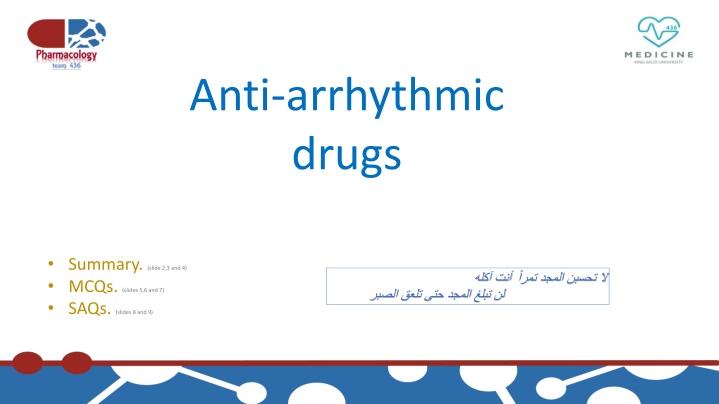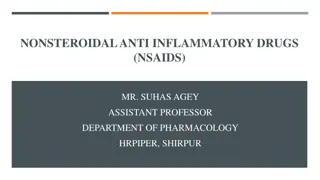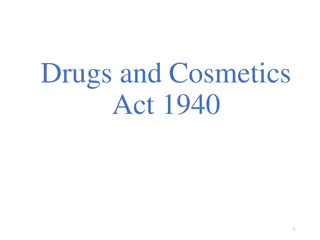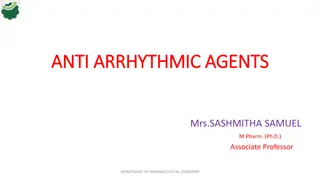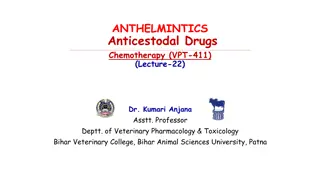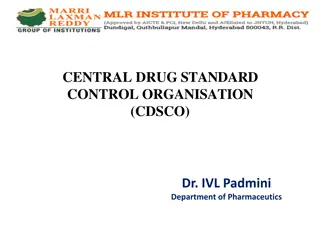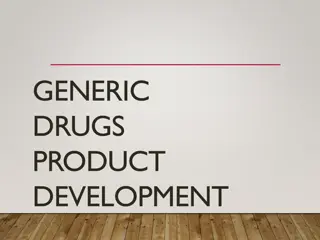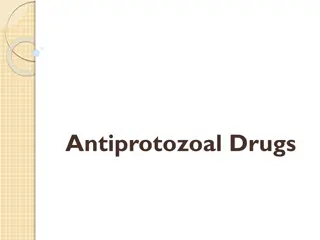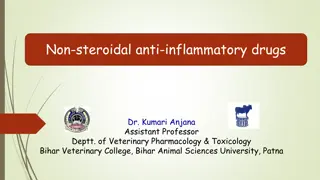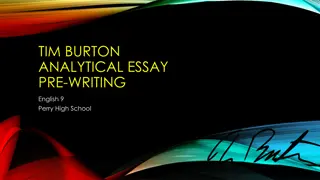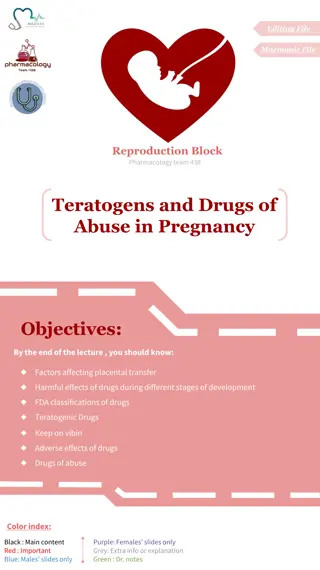Overview of Anti-Arrhythmic Drugs
Anti-arrhythmic drugs play a vital role in managing various heart rhythm disorders. This summary covers the classification, mechanisms of action, uses, and adverse effects of different classes of anti-arrhythmic drugs. Learn about Class I (IA, IB, IC), Class II, Class III, and Class IV drugs, along with their unique features and indications. Explore the importance of these medications in restoring normal cardiac rhythm and preventing serious arrhythmias.
Download Presentation

Please find below an Image/Link to download the presentation.
The content on the website is provided AS IS for your information and personal use only. It may not be sold, licensed, or shared on other websites without obtaining consent from the author.If you encounter any issues during the download, it is possible that the publisher has removed the file from their server.
You are allowed to download the files provided on this website for personal or commercial use, subject to the condition that they are used lawfully. All files are the property of their respective owners.
The content on the website is provided AS IS for your information and personal use only. It may not be sold, licensed, or shared on other websites without obtaining consent from the author.
E N D
Presentation Transcript
Anti-arrhythmic drugs Summary. (slide 2,3 and 4) MCQs. (slides 5,6 and 7) SAQs. (slides 8 and 9)
Then class I is subdivided into: Class IA: prolongation of the AP duration. Drugs in this group: Quinidine, procainamide. Class IB: shortening of the AP duration. Drugs in this group: Lidocaine, mexiletine. Class IC: has no effect on AP duration. Drugs in this group: Flecainide. The ultimate goal of anti-arrhythmic drugs is to restore normal rhythm and conduction by: Maintenance of normal rhythm. Prevention of more serious arrhythmias. Anti arrhythmic drugs produces there effect by: 1. Slow the conduction velocity. 2. Prolongation of effective refractory period. 3. Suppressing ectopic pacemaker activity by inhibiting phase 4 (slow depolarization). 2. Class II: Beta-adrenoceptor blockers. Drugs in this group: Esmolol, Propranolol, Atenolol, Metoropolol. 3. Class III: Drugs that prolong AP duration by prolongation of Phase 3. Drugs in this group: Amiodarone, and IBUTILIDE which is pure class III. Vaughn Williams classification of anti-arrhythmic drugs: 1. Class I: membrane stabilizing effect by blocking Na channels so On the cardiac muscle will decrease the rise of the depolarization phase. On the pacemaker will decrease the slow depolarization phase (phase 4). 4. Class IV: Calcium channel blockers mainly on the SA and AV nodes. Drugs in this group: Verapamil, diltiazem. 2
Drugs Special features Uses ECG changes ADRs Anti-cholinergic actions. Torsades de pointes arrhythmia even with normal doses. Hypotension. In long term therapy may cause lupus erythematosus-like syndrome. Hypotension. Hallucination and psychosis. Torsades de pointes arrhythmia. Class IA. Most toxic drug on the heart. Has anti-cholinergic effect. Prolong PR and QT intervals. Wide QRS complex. Atrial flutter and fibrillation. Maintain sinus rhythm after cardioversion. Quinidine Class IA. Less toxic than QUINIDINE. NO anti-cholinergic effect. Prolong PR and QT intervals. Wide QRS complex. More effective in ventricular arrhythmias than atrial ones. Procainamide Hypotension. Similar to other local anesthetics including convulsion, paresthesia, tremor, dysarthria, and tennitus. Class IB. Short half life. Note effective orally. Used in emergency ventricular arrhythmias like in surgery and after acute MI. Not effective in atrial arrhythmias. Lidocaine __________ Nausea, vomiting. Tremor, drowsiness, diplopia. Hypotension and other arrhythmias. Class IB. Effective orally. Ventricular arrhythmias. Digitalis induced arrhythmia. Mexiletine __________ Supraventricular arrhythmias. WPW syndrome. Effective in ventricular arrhythmias but high risk of proarrhythmias. Class IC. Should be reserved for resistant arrhythmias. Proarrhythmias. Dizziness, tremor and blurred vision. Heart failure due to ve inotropic effect. Flecainide __________ exacerbation of ventricular arrhythmias (with high dose). Bradycardia and HF. Pulmonary fibrosis. Check the rest in the main lecture. Mainly used in serious resistant ventricular arrhythmias. Supraventricular arrhythmias (e.g. WPW) Maintenance of sinus rhythm after cardioversion. Class III. Additional class IA, II and IC effect. Vasodilating effect. Amiodarone __________ Pure class III. Given by rapid IV infusion. Acute conversion of atrial flutter or fibrillation to normal sinus rhythm. Ibutilide QR interval prolongation. Mainly torsades de mointes arrhythmia. 3
Drug Special features Uses ADRs Atrial arrhythmias associated with emotions (e.g. exercise, thyrotoxicosis) Digitalis induced arrhythmias. WPW. ESMOLOL used for rapid control of ventricular rate in patient with atrial flutter or fibrillation. Others used in patient with MI to reduce incidence of sudden death due to ventricular arrhythmias. ESMOLOL Beta-blockers. Decrease automaticity of the SA node and ectopic pace maker. Prolong refractory period. ESMOLOL has a very short duration of action. Propranolol Check beta blockers lecture. Atenolol Metorpolol Class IV. Calcium channels blockers. Work on SA and AV nodes causing: Slow conduction. Prolongation of refractory period. Verapamil Atrial arrhythmias. Re-entry supraventricular arrhythmias (e.g. WPW) NOT effective in ventricular arrhythmias. ______________ Diltiazem Flushing n 20% of patients. Shortness of breath and chest burning in 10% of patients. Brief AV block. (contra indicated in heart block) Inhibiting of cAMP causing : Hyperpolarization. Negative dromotropic effect. Negative chronotropic effect. Half life less than 10 seconeds. New anti-arrhythmic drug. Non-iodinated congener of amiodarone. Anti-arrhythmic properties related to all classes. should not be used in patients with severe (class IV) heart failure. Risk of death may be increased in these patients. should not be used in patients with permanent atrial fibrillation. Risk of death and stroke, may be increased in these patients. drug of choice for acute management of paroxysmal supraventricular tachycardia. Preferred over verapamil because it s safer and does not depress contractility. Adenosine Used for maintenance of sinus rhythm following cardioversion in patients with atrial fibrillation Dronedarone ______________ Usen in sinus bradycardia after MI and in heart block. In emergency of heart block and may combined with isoprenaline. Brady arrhythmia drug. Atropine ______________ 4
MCQs 1. Which of the following classes has no effect on phase 4 of the AP of the pacemaker? A) Ia B) II C) III D) IV 2. A patient took class I anti-arrhythmic drugs which resulted in shortening of the AP duration. Which class did the patient take? A) Ia B) Ib C) Ic D) III 3. Which of the following drugs have short duration of action, confusion and convulsion as ADRs? A) Lidocaine. B) Mexiletine. C) Flecainide. D) Quinidine. 4. A 78-year-old female has been newly diagnosed with atrial fibrillation. She is not currently having any symptoms of palpitation or fatigue. Which of the following is appropriate to initiate for rate control as an outpatient? A) Dronedarone.. B) Esmolol.. C) Flecainide. D) Metoprolol. 5. All the following are adverse effect of amiodarone except: A) Cinchonism. B) Hypothyroidism. C) Hyperthyroidism. D) Pulmonary fibrosis. 6. Which of the following can be treated with Lidocaine? A) Paroxysmal supraventricular tachycardia. B) Atrial fibrillation. C) atrial flutter. D) Ventricular tachycardia. 6:D 5:A 4:D 3:A 2:B Explanation for Q4 Only B and D are options to control rate. The other options are used for rhythm control in patients with atrial fibrillation. Since esmolol is IV only, the only option to start as an outpatient is metoprolol. 1:C Answers 5
Cont. MCQs 7. A clinician would like to initiate a drug for rhythm control of atrial fibrillation. Which of the following coexisting conditions would allow him for the initiation of flecainide? A) Hypertension. B) Left ventricular hypertrophy. C) Coronary artery disease. D) Heart failure. 8. Which of the following is the dominant effect of amiodarone? A) Prolongation of AP. B) Increase duration of refractory period by blocking K+ channels. C) Vasodilating effect. D) Additional class Ia, II and IV. 9. What is the ultimate of anti-arrhythmic therapy A) Maintenance of normal rhythm. B) Prevention of more serious arrhythmias. C) A & B D) Decrease the conduction velocity of the AV node. 10.Patient had a severe heart failure and the risk of his death is too high. Which of the following drugs is prohibited is his case? A) Atropine. B) Lidocaine. C) Dronedarone. D) Quinidine. 11.Which of the following drugs is very effective in ventricular arrhythmias but also could cause Proarrhythmia? A) flecainide. B) Esmolol. C)Atropine. D) Metoprolol. 12.Which of the following drugs could cause tosades de pointes arrhythmia even within the normal therapeutic range? A) Atropine. B) Lidocaine. C) Dronedarone. D) Quinidine. 12:D 11:A 10:C 9:C 8:A Explanation for Q7 Since flecainide can increase the risk of sudden cardiac death in those with a history of structural heart disease, only A will allow for flecainide initiation. Structural heart disease includes left ventricular hypertrophy, heart failure, and atherosclerotic heart disease. 7:A Answers 6
Cont. MCQs 13.Which of the following drugs that may induce a very serious arrhythmia that is stronger and more dangerous than the treated one? A) Mexiletine. B) Esmolol.. C) Flecainide. D) Metoprolol. 14.A patient was in the OR doing a knee joint replacement, suddenly he developed some sort of ventricular arrhythmia. What is the drug of choice in this case? A) Lidocaine. B) Esmolol. C) Verapamil. D) Procainamide. 15.Which one of the following anti-arrhythmia drugs is NOT effective in atrial arrhythmias ? A) Verapamil. B) Lidocaine. C) Ibutilide. D) Quinidine. 16.A 67-year-old male who develop bradyarrhytmia after myocardial infarction, which anti-arrhythmia drug can be used in this case ? A) Atropine. B) Lidocaine. C) Dronedarone. D) Quinidine. 17.A medical student in his last year, had an important presentation on front of a huge crowded audience and he was very nervous about it. 13.Which of the following classes you think that will help him to calm down and slow his heart rate? A) CLASS II. B) CLASS Ib. C) CLASS III. D) CLASS Ia. 18.A group of student had a research about patients with myocardial infarction, they divided the patient into 4 groups and gave them a group of different drugs, ESMOLOL, PROPRANOLOL, ATENOLOL, and METOPROLOL. They noticed one of the groups had no changes in the mortality rate, which one of te drugs you think that resulted in no changes in the mortality rate. A) Propranolol. B) Esmolol. C) Atenolol. D) Metoprolol. 18:B 17:A 16:A 15:B 14:A 13:C Answers 7
SAQ a patient arrived to ER that seemed to have irregular heart beat, after investigations it turned that he had previous record of ventricular arrhythmia. Q1: Name the drug that should be used in his case? Lidocaine Q2: What is the half life of that drug ? 2 Hours Q3: What is a possible route of administration for the drug ? Given I.V. bolus or slow infusion Q4: What should be the prescribed drug for the patient after he leave the hospital ? Mexiletine Q5: What is the class of those drugs ? CLASS IB Q6: Name one adverse effect that may results from both drugs. Paresthesia / Tremor / Dysarthria (slurred speech ) / Convulsions 8
SAQ A 42-year-old male presents to ER complaining of palpitation. On physical examination, he s cool to touch, diaphoretic, and mildly hypotensive with a blood pressure of 90/50 mmHg, his ECG demonstrates an irregular supraventricular tachycardia at a rate of 144 beats/min, likely consist with atrial fibrillation. This is his third presentation to the hospital with supraventricular tachycardia in the two months. After you stabilize the patient and control his heart rate, you call for a cardiology consult to assess whether the patient might be a candidate for treatment with an anti-arrhythmic medication. When the cardiologist arrives, he suggests placing the patient on an agent that acts by blocking sodium channels in the cardiac myocyte, but he states that this medication should only be used in patients with structurally normal heart. Q1: Which group of drugs did the cardiologist suggest? Class IC drugs including flecainide. Q2: What is effect of this class on the duration of action potential? It has no effect on the duration of action potential. Q3: What is the clinical uses of this class? Treatment of supraventricular arrhythmias. Q4: What is the major side effects in this class? Proarrhythmias. CNS side effects including tremor dizziness and blurred vision. Heart failure due to ve inotropic effect. 9
Done by: Revised by: Abdulaziz Redwan Abdulrahman Thekry Abdulrahman Thekry Ghadah Almuhana Rawan Alqahtani Contact us : @Pharma436 Pharma436@outlook.com
